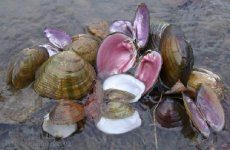Caitlin
Well-known member
- Joined
- Dec 11, 2004
- Messages
- 8,502
http://unionid.missouristate.edu/
Go to the link to click on the photos. They will amze youThese photographs and videos are intended to encourage interest in the freshwater pearly mussels (Unionoida) and promote the conservation of endangered species. Students, teachers and biologists are welcome to use the images for non-commercial educational purposes (see use policy). Winter raccoon kills on the Verdigris River, Kansas
IntroductionThe rivers of North America are home to nearly 300 species of native freshwater pearly mussels. However, the destruction of river habitats by dams, channelization, erosion and pollution has left many of these amazing mollusks on the brink of extinction. Presently 71 native mussels are on the U.S. endangered species list. Mussels don't have a glamorous public image like pandas or tigers, yet the more we learn more about them the more remarkable they seem.
Perhaps the most surprising aspect of native mussels is their symbiosis with fish. Females release tiny larvae called glochidia. The glochidia must attach to the gills or fins of particular species of fish, where they remain for several days or weeks as they metamorphose into juvenile mussels. Mussels have evolved incredible devices to lure fishes and ensure that the glochidia become attached. The photos and videos displayed on the following pages illustrate some of these remarkable adaptations.
Click on the photos to link to the image pages.
Attachments
Last edited:


